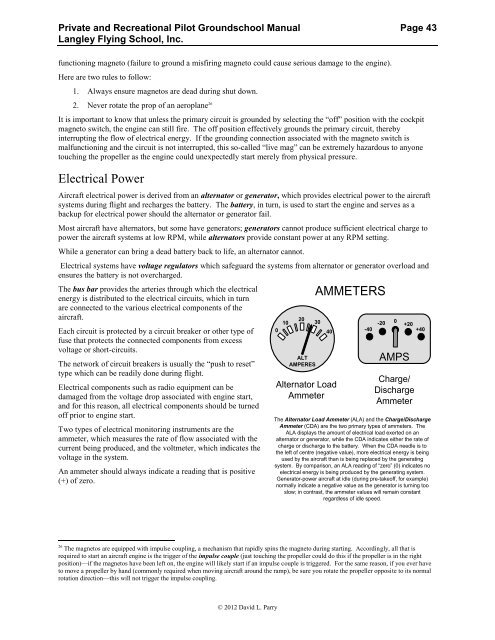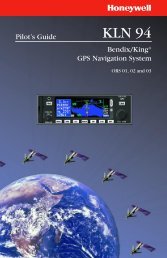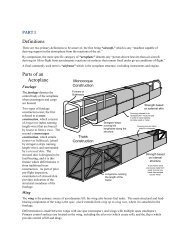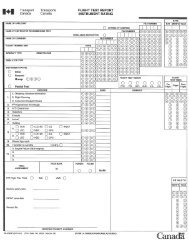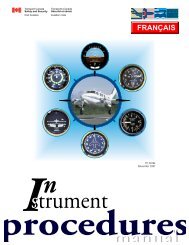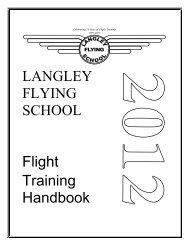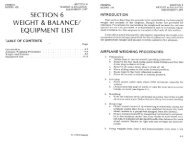Langley Flying School Private Pilot Groundschool Manual Sample ...
Langley Flying School Private Pilot Groundschool Manual Sample ...
Langley Flying School Private Pilot Groundschool Manual Sample ...
Create successful ePaper yourself
Turn your PDF publications into a flip-book with our unique Google optimized e-Paper software.
<strong>Private</strong> and Recreational <strong>Pilot</strong> <strong>Groundschool</strong> <strong>Manual</strong> Page 43<strong>Langley</strong> <strong>Flying</strong> <strong>School</strong>, Inc.functioning magneto (failure to ground a misfiring magneto could cause serious damage to the engine).Here are two rules to follow:1. Always ensure magnetos are dead during shut down.2. Never rotate the prop of an aeroplane 26It is important to know that unless the primary circuit is grounded by selecting the “off” position with the cockpitmagneto switch, the engine can still fire. The off position effectively grounds the primary circuit, therebyinterrupting the flow of electrical energy. If the grounding connection associated with the magneto switch ismalfunctioning and the circuit is not interrupted, this so-called “live mag” can be extremely hazardous to anyonetouching the propeller as the engine could unexpectedly start merely from physical pressure.Electrical PowerAircraft electrical power is derived from an alternator or generator, which provides electrical power to the aircraftsystems during flight and recharges the battery. The battery, in turn, is used to start the engine and serves as abackup for electrical power should the alternator or generator fail.Most aircraft have alternators, but some have generators; generators cannot produce sufficient electrical charge topower the aircraft systems at low RPM, while alternators provide constant power at any RPM setting.While a generator can bring a dead battery back to life, an alternator cannot.Electrical systems have voltage regulators which safeguard the systems from alternator or generator overload andensures the battery is not overcharged.The bus bar provides the arteries through which the electricalenergy is distributed to the electrical circuits, which in turnare connected to the various electrical components of theaircraft.Each circuit is protected by a circuit breaker or other type offuse that protects the connected components from excessvoltage or short-circuits.The network of circuit breakers is usually the “push to reset”type which can be readily done during flight.Electrical components such as radio equipment can bedamaged from the voltage drop associated with engine start,and for this reason, all electrical components should be turnedoff prior to engine start.Two types of electrical monitoring instruments are theammeter, which measures the rate of flow associated with thecurrent being produced, and the voltmeter, which indicates thevoltage in the system.An ammeter should always indicate a reading that is positive(+) of zero.01020ALTAMPERES3040Alternator LoadAmmeterAMMETERS-40-20 0AMPS+20+40Charge/DischargeAmmeterThe Alternator Load Ammeter (ALA) and the Charge/DischargeAmmeter (CDA) are the two primary types of ammeters. TheALA displays the amount of electrical load exerted on analternator or generator, while the CDA indicates either the rate ofcharge or discharge to the battery. When the CDA needle is tothe left of centre (negative value), more electrical energy is beingused by the aircraft than is being replaced by the generatingsystem. By comparison, an ALA reading of “zero” (0) indicates noelectrical energy is being produced by the generating system.Generator-power aircraft at idle (during pre-takeoff, for example)normally indicate a negative value as the generator is turning tooslow; in contrast, the ammeter values will remain constantregardless of idle speed.26 The magnetos are equipped with impulse coupling, a mechanism that rapidly spins the magneto during starting. Accordingly, all that isrequired to start an aircraft engine is the trigger of the impulse couple (just touching the propeller could do this if the propeller is in the rightposition)—if the magnetos have been left on, the engine will likely start if an impulse couple is triggered. For the same reason, if you ever haveto move a propeller by hand (commonly required when moving aircraft around the ramp), be sure you rotate the propeller opposite to its normalrotation direction—this will not trigger the impulse coupling.© 2012 David L. Parry


